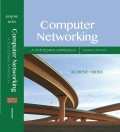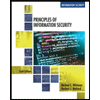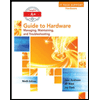
EBK COMPUTER NETWORKING
7th Edition
ISBN: 8220102955479
Author: Ross
Publisher: PEARSON
expand_more
expand_more
format_list_bulleted
Question
Chapter 3, Problem P27P
a)
Program Plan Intro
Given scenario:
- The Host A and B are communicating over TCP, Host B has already received all bytes from Host A up through 126 byte. If first and second segments have 80 and 40 bytes of data, the first segment has the sequence number 127, source port number 302, and destination port number 80.
b)
Program Plan Intro
Given scenario:
- The Host A and B are communicating over TCP, Host B has already received all bytes from Host A up through 126 byte. If first and second segments have 80 and 40 bytes of data, the first segment has the sequence number 127, source port number 302, and destination port number 80.
c)
Program Plan Intro
Given scenario:
- The Host A and B are communicating over TCP, Host B has already received all bytes from Host A up through 126 byte. If first and second segments have 80 and 40 bytes of data, the first segment has the sequence number 127, source port number 302, and destination port number 80.
d)
Program Plan Intro
Given scenario:
- The Host A and B are communicating over TCP, Host B has already received all bytes from Host A up through 126 byte. If first and second segments have 80 and 40 bytes of data, the first segment has the sequence number 127, source port number 302, and destination port number 80.
Expert Solution & Answer
Want to see the full answer?
Check out a sample textbook solution
Students have asked these similar questions
Considering the TM example of binary sum ( see attached)do the step-by-step of execution for the binary numbers 1101 and 11.
Feel free to use the Formal Language Editor Tool to execute it;
Write it down the current state of the tape (including the head position) and indicate the current state of the TM at each step.
I need help on inculding additonal code where I can can do the opposite code of MatLab, where the function of t that I enter becomes the result of F(t), in other words, turning the time-domain f(t) into the frequency-domain function F(s):
I need help with the TM computation step-by-step execution for the binary numbers 1101 and 11.
Formal Language Editor Tool can be used to execute it; Write it down the current state of the tape (including the head position) and indicate the current state of the TM at each step;
Chapter 3 Solutions
EBK COMPUTER NETWORKING
Ch. 3 - Prob. R1RQCh. 3 - Prob. R2RQCh. 3 - Consider a TCP connection between Host A and Host...Ch. 3 - Prob. R4RQCh. 3 - Prob. R5RQCh. 3 - Prob. R6RQCh. 3 - Suppose a process in Host C has a UDP socket with...Ch. 3 - Prob. R8RQCh. 3 - Prob. R9RQCh. 3 - In our rdt protocols, why did we need to introduce...
Ch. 3 - Prob. R11RQCh. 3 - Prob. R12RQCh. 3 - Prob. R13RQCh. 3 - Prob. R14RQCh. 3 - Suppose Host A sends two TCP segments back to back...Ch. 3 - Prob. R16RQCh. 3 - Prob. R17RQCh. 3 - Prob. R18RQCh. 3 - Prob. R19RQCh. 3 - Prob. P1PCh. 3 - Prob. P2PCh. 3 - UDP and TCP use 1s complement for their checksums....Ch. 3 - Prob. P4PCh. 3 - Prob. P5PCh. 3 - Prob. P6PCh. 3 - Prob. P7PCh. 3 - Prob. P8PCh. 3 - Prob. P9PCh. 3 - Prob. P10PCh. 3 - Prob. P11PCh. 3 - Prob. P12PCh. 3 - Prob. P13PCh. 3 - Prob. P14PCh. 3 - Prob. P15PCh. 3 - Prob. P16PCh. 3 - Prob. P17PCh. 3 - Prob. P21PCh. 3 - Prob. P22PCh. 3 - Prob. P25PCh. 3 - Prob. P26PCh. 3 - Prob. P27PCh. 3 - Host A and B are directly connected with a 100...Ch. 3 - Prob. P29PCh. 3 - Prob. P30PCh. 3 - Prob. P31PCh. 3 - Prob. P33PCh. 3 - Prob. P34PCh. 3 - Prob. P35PCh. 3 - Prob. P37PCh. 3 - Prob. P38PCh. 3 - Prob. P39PCh. 3 - Prob. P41PCh. 3 - Prob. P42PCh. 3 - Prob. P43PCh. 3 - Prob. P44PCh. 3 - Prob. P45PCh. 3 - Prob. P46PCh. 3 - Prob. P47PCh. 3 - Prob. P48PCh. 3 - Prob. P49PCh. 3 - Prob. P51PCh. 3 - Prob. P53PCh. 3 - Prob. P55P
Knowledge Booster
Similar questions
- Ensure you answer the question asked at the end of the document. Do not just paste things without the GNS3 console outputsarrow_forward"Do not use AI tools. Solve the problem by hand on paper only and upload a photo of your handwritten solution."arrow_forward"Do not use AI tools. Solve the problem by hand on paper only and upload a photo of your handwritten solution."arrow_forward
- "Do not use AI tools. Solve the problem by hand on paper only and upload a photo of your handwritten solution."arrow_forward"Do not use AI tools. Solve the problem by hand on paper only and upload a photo of your handwritten solution."arrow_forwardSolve this "Do not use AI tools. Solve the problem by hand on paper only and upload a photo of your handwritten solution."arrow_forward
- "Do not use AI tools. Solve the problem by hand on paper only and upload a photo of your handwritten solution."arrow_forward"Do not use AI tools. Solve the problem by hand on paper only and upload a photo of your handwritten solution."arrow_forwardSpecifications: Part-1Part-1: DescriptionIn this part of the lab you will build a single operation ALU. This ALU will implement a bitwise left rotation. Forthis lab assignment you are not allowed to use Digital's Arithmetic components.IF YOU ARE FOUND USING THEM, YOU WILL RECEIVE A ZERO FOR LAB2!The ALU you will be implementing consists of two 4-bit inputs (named inA and inB) and one 4-bit output (named out). Your ALU must rotate the bits in inA by the amount given by inB (i.e. 0-15).Part-1: User InterfaceYou are provided an interface file lab2_part1.dig; start Part-1 from this file.NOTE: You are not permitted to edit the content inside the dotted lines rectangle. Part-1: ExampleIn the figure above, the input values that we have selected to test are inA = {inA_3, inA_2, inA_1, inA_0} = {0, 1, 0,0} and inB = {inB_3, inB_2, inB_1, inB_0} = {0, 0, 1, 0}. Therefore, we must rotate the bus 0100 bitwise left by00102, or 2 in base 10, to get {0, 0, 0, 1}. Please note that a rotation left is…arrow_forward
arrow_back_ios
SEE MORE QUESTIONS
arrow_forward_ios
Recommended textbooks for you
 Systems ArchitectureComputer ScienceISBN:9781305080195Author:Stephen D. BurdPublisher:Cengage Learning
Systems ArchitectureComputer ScienceISBN:9781305080195Author:Stephen D. BurdPublisher:Cengage Learning Principles of Information Security (MindTap Cours...Computer ScienceISBN:9781337102063Author:Michael E. Whitman, Herbert J. MattordPublisher:Cengage Learning
Principles of Information Security (MindTap Cours...Computer ScienceISBN:9781337102063Author:Michael E. Whitman, Herbert J. MattordPublisher:Cengage Learning Operations Research : Applications and AlgorithmsComputer ScienceISBN:9780534380588Author:Wayne L. WinstonPublisher:Brooks Cole
Operations Research : Applications and AlgorithmsComputer ScienceISBN:9780534380588Author:Wayne L. WinstonPublisher:Brooks Cole A+ Guide To It Technical SupportComputer ScienceISBN:9780357108291Author:ANDREWS, Jean.Publisher:Cengage,
A+ Guide To It Technical SupportComputer ScienceISBN:9780357108291Author:ANDREWS, Jean.Publisher:Cengage, A+ Guide to Hardware (Standalone Book) (MindTap C...Computer ScienceISBN:9781305266452Author:Jean AndrewsPublisher:Cengage Learning
A+ Guide to Hardware (Standalone Book) (MindTap C...Computer ScienceISBN:9781305266452Author:Jean AndrewsPublisher:Cengage Learning Principles of Information Systems (MindTap Course...Computer ScienceISBN:9781285867168Author:Ralph Stair, George ReynoldsPublisher:Cengage Learning
Principles of Information Systems (MindTap Course...Computer ScienceISBN:9781285867168Author:Ralph Stair, George ReynoldsPublisher:Cengage Learning

Systems Architecture
Computer Science
ISBN:9781305080195
Author:Stephen D. Burd
Publisher:Cengage Learning

Principles of Information Security (MindTap Cours...
Computer Science
ISBN:9781337102063
Author:Michael E. Whitman, Herbert J. Mattord
Publisher:Cengage Learning

Operations Research : Applications and Algorithms
Computer Science
ISBN:9780534380588
Author:Wayne L. Winston
Publisher:Brooks Cole

A+ Guide To It Technical Support
Computer Science
ISBN:9780357108291
Author:ANDREWS, Jean.
Publisher:Cengage,

A+ Guide to Hardware (Standalone Book) (MindTap C...
Computer Science
ISBN:9781305266452
Author:Jean Andrews
Publisher:Cengage Learning

Principles of Information Systems (MindTap Course...
Computer Science
ISBN:9781285867168
Author:Ralph Stair, George Reynolds
Publisher:Cengage Learning